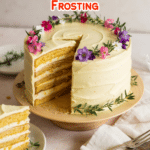Elegant Browned Butter Cake with Vanilla-Honey Frosting & Candied Thyme
Bake a sophisticated Browned Butter Cake! This recipe features a tender cake made with nutty browned butter, frosted with a creamy vanilla-honey cream cheese frosting, and garnished with elegant candied thyme.
Ingredients
Candied Thyme:
- ▢ 2 egg whites, beaten until frothy
- ▢ 20 thyme sprigs
- ▢ 1 cup granulated sugar
Cake:
- ▢ 3 cups cake flour, sifted
- ▢ 1 ½ teaspoon baking powder
- ▢ ¾ teaspoon baking soda
- ▢ ½ teaspoon salt
- ▢ 1 ¾ cups superfine sugar (or granulated)
- ▢ 1 cup unsalted butter, browned and cooled (see step 1 below)
- ▢ 3 large eggs, lightly beaten (room temperature preferred)
- ▢ 1 ½ cups whole milk (room temperature preferred)
- ▢ 2 teaspoons vanilla extract
Vanilla-Honey Frosting:
- ▢ ½ cup (1 stick) unsalted butter, softened
- ▢ 4 ounces cream cheese, softened
- ▢ 2 tablespoons honey
- ▢ 2 ½ to 3 cups powdered sugar, sifted
- ▢ 1 teaspoon vanilla extract
- ▢ milk, as needed (1 tablespoon at a time)
Garnishes:
- ▢ Candied thyme sprigs (from above)
- ▢ Edible flowers (optional)
Instructions
1. Make the Candied Thyme:
- Prepare the candied thyme first to allow drying time. In a small bowl, beat the egg whites until just frothy.
- Place the 1 cup of granulated sugar in a shallow dish or plate.
- Fully dip each fresh thyme sprig into the frothed egg whites, letting excess drip off.
- Carefully dredge each coated sprig in the sugar until fully coated, shaking off any excess sugar.
- Place each coated thyme sprig onto a wire rack set over a baking sheet. Allow the sprigs to air dry completely until crisp, at least 1 hour, or ideally longer (can be made 1-2 days ahead and stored carefully in an airtight container once dry).
2. Brown the Butter:
- Place the 1 cup (2 sticks) of unsalted butter in a medium, light-colored saucepan over medium heat.
- Melt the butter, then continue cooking, swirling the pan occasionally. The butter will foam, then subside. Watch carefully as golden brown specks (toasted milk solids) begin to form at the bottom and the butter develops a nutty aroma.
- Once the butter is amber brown and smells nutty (this can take 5-10 minutes), immediately remove it from the heat and pour it into a heatproof bowl to stop the cooking. Be careful not to burn the solids.
- Let the browned butter cool completely to room temperature before using in the cake batter.
3. Prepare Oven and Pans:
- Preheat oven to 350°F (175°C).
- Prepare three cake pans (likely 8-inch or 9-inch rounds) by greasing them and lining the bottoms with parchment paper circles. Grease the parchment as well.
4. Mix Cake Batter:
- In a large mixing bowl, sift or whisk together the cake flour, baking powder, baking soda, and salt.
- In another large mixing bowl, whisk together the superfine (or granulated) sugar, the cooled browned butter, and the lightly beaten eggs until combined.
- Pour the flour mixture into the egg/butter mixture and whisk together until very thick and just combined.
- Stir in the whole milk and vanilla extract until fully incorporated and the batter is smooth. Do not overmix.
5. Bake the Cakes:
- Pour the batter evenly into the three prepared cake pans.
- Bake for 25 to 30 minutes, or until a toothpick inserted into the center of the cake comes out clean.
- Allow the cakes to cool in the pans on wire racks for 15 to 20 minutes.
- Carefully invert the cakes onto the wire racks, remove the parchment paper, and allow them to cool completely.
6. Make the Vanilla-Honey Frosting:
- Ensure butter and cream cheese are properly softened.
- Place the softened butter, softened cream cheese, and honey into the bowl of a stand mixer fitted with the paddle attachment (or use an electric hand mixer).
- Whip on medium-high speed until light and fluffy.
- Reduce speed to low. Gradually add the sifted powdered sugar, ½ cup at a time, mixing until fully incorporated after each addition.
- Add the vanilla extract. Increase speed to medium-high and continue to beat until the frosting is very light and fluffy.
- Check consistency: If the frosting seems too stiff, beat in milk, 1 tablespoon at a time, until it reaches a smooth, spreadable consistency.
7. Assemble the Cake:
- If necessary, level the tops of the cooled cake layers. Place the first layer on your serving plate or cake stand.
- Spread a thin, even layer of the vanilla-honey frosting over the top.
- Place the second cake layer on top, inverted (bottom side up, if leveled) or right side up. Spread another layer of frosting.
- Place the third cake layer on top (preferably inverted for a flat top).
- Apply a thin “crumb coat” of frosting over the entire cake (top and sides) to seal in crumbs. Chill for 15-20 minutes.
8. Final Frosting and Decoration:
- Apply the remaining frosting smoothly or decoratively over the top and sides of the chilled cake using an offset spatula.
- Gently place a ‘crown’ of candied thyme sprigs around the base and/or top edge of the cake.
- Add edible flowers for extra decoration, if desired.
- Let the cake sit briefly before serving, or store refrigerated (let come towards room temp before serving).
